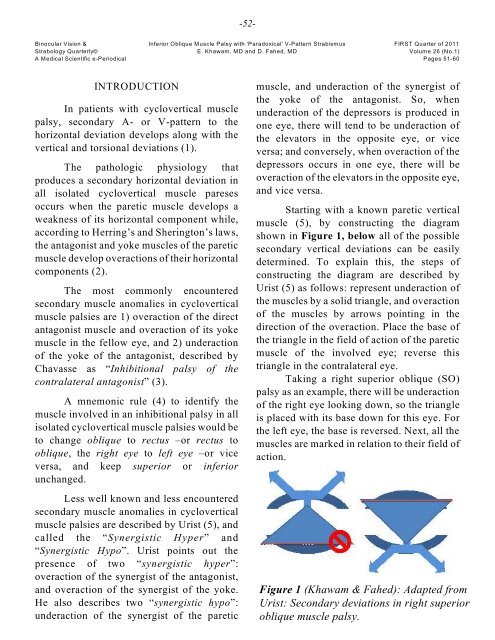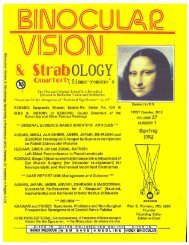Correspondence - ICO Library
Correspondence - ICO Library
Correspondence - ICO Library
Create successful ePaper yourself
Turn your PDF publications into a flip-book with our unique Google optimized e-Paper software.
-52-<br />
Binocular Vision & Inferior Oblique Muscle Palsy with ‘Paradoxical’ V-Pattern Strabismus FIRST Quarter of 2011<br />
Strabology Quarterly© E. Khawam, MD and D. Fahed, MD Volume 26 (No.1)<br />
A Medical Scientific e-Periodical Pages 51-60<br />
INTRODUCTION<br />
In patients with cyclovertical muscle<br />
palsy, secondary A- or V-pattern to the<br />
horizontal deviation develops along with the<br />
vertical and torsional deviations (1).<br />
The pathologic physiology that<br />
produces a secondary horizontal deviation in<br />
all isolated cyclovertical muscle pareses<br />
occurs when the paretic muscle develops a<br />
weakness of its horizontal component while,<br />
according to Herring’s and Sherington’s laws,<br />
the antagonist and yoke muscles of the paretic<br />
muscle develop overactions of their horizontal<br />
components (2).<br />
The most commonly encountered<br />
secondary muscle anomalies in cyclovertical<br />
muscle palsies are 1) overaction of the direct<br />
antagonist muscle and overaction of its yoke<br />
muscle in the fellow eye, and 2) underaction<br />
of the yoke of the antagonist, described by<br />
Chavasse as “Inhibitional palsy of the<br />
contralateral antagonist” (3).<br />
A mnemonic rule (4) to identify the<br />
muscle involved in an inhibitional palsy in all<br />
isolated cyclovertical muscle palsies would be<br />
to change oblique to rectus –or rectus to<br />
oblique, the right eye to left eye –or vice<br />
versa, and keep superior or inferior<br />
unchanged.<br />
Less well known and less encountered<br />
secondary muscle anomalies in cyclovertical<br />
muscle palsies are described by Urist (5), and<br />
called the “Synergistic Hyper” and<br />
“Synergistic Hypo”. Urist points out the<br />
presence of two “synergistic hyper”:<br />
overaction of the synergist of the antagonist,<br />
and overaction of the synergist of the yoke.<br />
He also describes two “synergistic hypo”:<br />
underaction of the synergist of the paretic<br />
muscle, and underaction of the synergist of<br />
the yoke of the antagonist. So, when<br />
underaction of the depressors is produced in<br />
one eye, there will tend to be underaction of<br />
the elevators in the opposite eye, or vice<br />
versa; and conversely, when overaction of the<br />
depressors occurs in one eye, there will be<br />
overaction of the elevators in the opposite eye,<br />
and vice versa.<br />
Starting with a known paretic vertical<br />
muscle (5), by constructing the diagram<br />
shown in Figure 1, below all of the possible<br />
secondary vertical deviations can be easily<br />
determined. To explain this, the steps of<br />
constructing the diagram are described by<br />
Urist (5) as follows: represent underaction of<br />
the muscles by a solid triangle, and overaction<br />
of the muscles by arrows pointing in the<br />
direction of the overaction. Place the base of<br />
the triangle in the field of action of the paretic<br />
muscle of the involved eye; reverse this<br />
triangle in the contralateral eye.<br />
Taking a right superior oblique (SO)<br />
palsy as an example, there will be underaction<br />
of the right eye looking down, so the triangle<br />
is placed with its base down for this eye. For<br />
the left eye, the base is reversed. Next, all the<br />
muscles are marked in relation to their field of<br />
action.<br />
Figure 1 (Khawam & Fahed): Adapted from<br />
Urist: Secondary deviations in right superior<br />
oblique muscle palsy.









